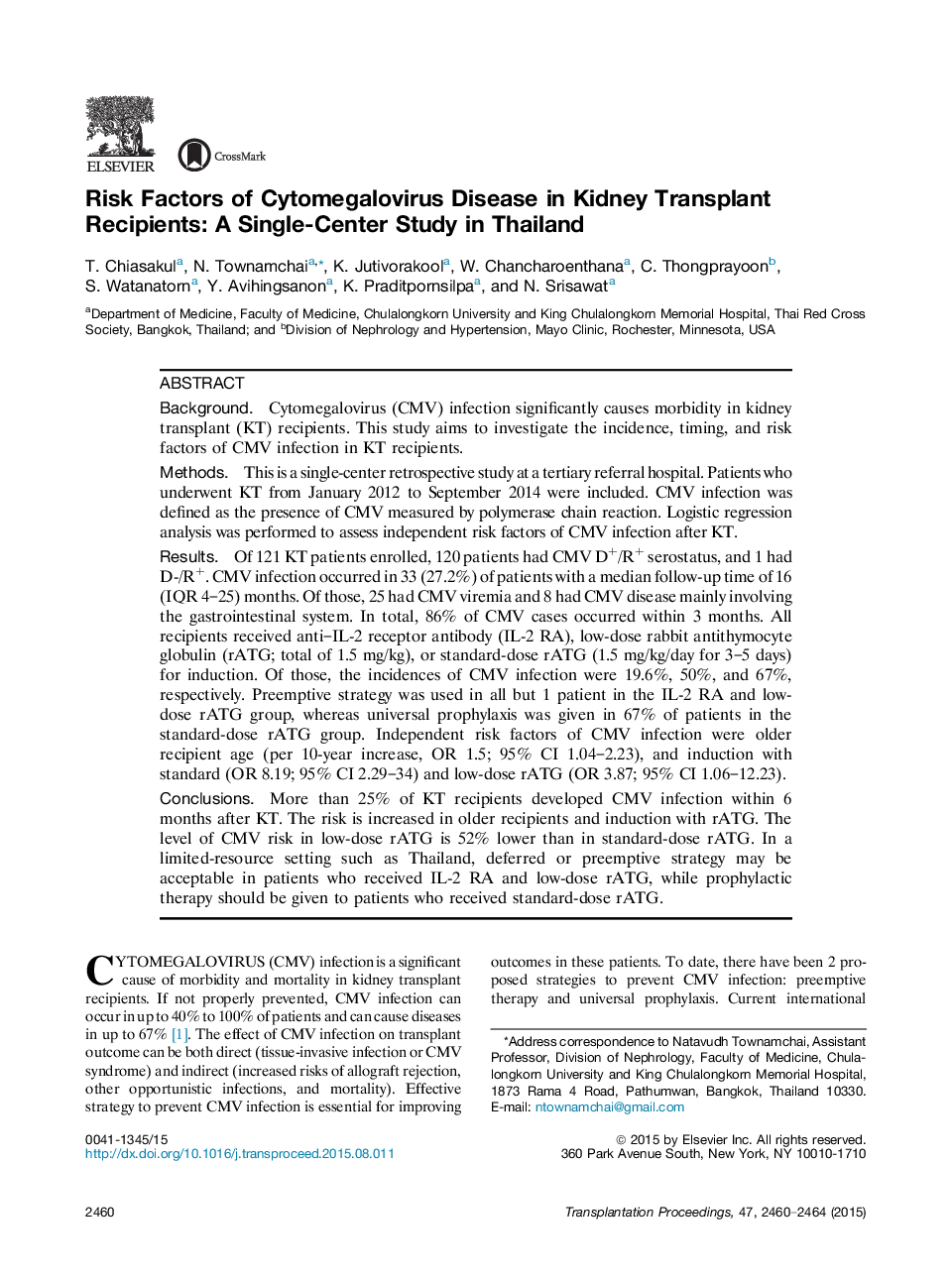| کد مقاله | کد نشریه | سال انتشار | مقاله انگلیسی | نسخه تمام متن |
|---|---|---|---|---|
| 4257023 | 1284537 | 2015 | 5 صفحه PDF | دانلود رایگان |
• Effective strategy to prevent CMV infection is essential for improving outcome in kidney transplant recipients but may not be feasible for limited-resource settings.
• We investigated the incidence, timing, and characteristics of CMV infection in kidney transplant recipients, as well as identifying the risk factors for developing CMV infection and disease in this limited-resource setting.
• The incidences of CMV infection were 19.6%, 50%, and 67% in recipients who received anti-IL-2 receptor antibody, low-dose rabbit anti-thymocyte globulin (rATG; total of 1.5 mg/kg), or standard-dose rATG (1.5 mg/kg/day for 3–5 days) for induction, respectively.
• In a limited-resource setting such as Thailand, deferred or preemptive strategy may be acceptable in patients who received anti-IL-2 receptor antibody and low-dose rATG, while prophylactic therapy should be given to patients who received standard-dose rATG.
BackgroundCytomegalovirus (CMV) infection significantly causes morbidity in kidney transplant (KT) recipients. This study aims to investigate the incidence, timing, and risk factors of CMV infection in KT recipients.MethodsThis is a single-center retrospective study at a tertiary referral hospital. Patients who underwent KT from January 2012 to September 2014 were included. CMV infection was defined as the presence of CMV measured by polymerase chain reaction. Logistic regression analysis was performed to assess independent risk factors of CMV infection after KT.ResultsOf 121 KT patients enrolled, 120 patients had CMV D+/R+ serostatus, and 1 had D-/R+. CMV infection occurred in 33 (27.2%) of patients with a median follow-up time of 16 (IQR 4–25) months. Of those, 25 had CMV viremia and 8 had CMV disease mainly involving the gastrointestinal system. In total, 86% of CMV cases occurred within 3 months. All recipients received anti–IL-2 receptor antibody (IL-2 RA), low-dose rabbit antithymocyte globulin (rATG; total of 1.5 mg/kg), or standard-dose rATG (1.5 mg/kg/day for 3–5 days) for induction. Of those, the incidences of CMV infection were 19.6%, 50%, and 67%, respectively. Preemptive strategy was used in all but 1 patient in the IL-2 RA and low-dose rATG group, whereas universal prophylaxis was given in 67% of patients in the standard-dose rATG group. Independent risk factors of CMV infection were older recipient age (per 10-year increase, OR 1.5; 95% CI 1.04–2.23), and induction with standard (OR 8.19; 95% CI 2.29–34) and low-dose rATG (OR 3.87; 95% CI 1.06–12.23).ConclusionsMore than 25% of KT recipients developed CMV infection within 6 months after KT. The risk is increased in older recipients and induction with rATG. The level of CMV risk in low-dose rATG is 52% lower than in standard-dose rATG. In a limited-resource setting such as Thailand, deferred or preemptive strategy may be acceptable in patients who received IL-2 RA and low-dose rATG, while prophylactic therapy should be given to patients who received standard-dose rATG.
Journal: Transplantation Proceedings - Volume 47, Issue 8, October 2015, Pages 2460–2464
